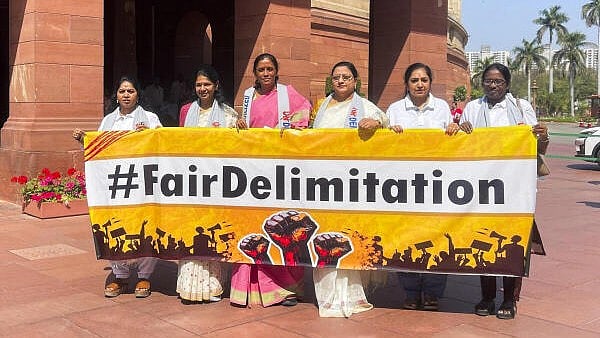
DMK and INDIA bloc MPs Kanimozhi Karunanidhi, Jothimani Sennimalai, Kanimozhi NVN Somu, T Sumathy and others protest on the issue of delimitation during the Budget session of Parliament
Credit: PTI Photo
Calling for a freeze on delimitation for another 30 years, as demanded by the politicians from South Indian states at the recent meeting in Chennai, is anti-Dalit, anti-woman and anti-democratic. It betrays the very constitutional values that these very same politicians claim to cherish and uphold in other contexts. Here is why.
Anti-Dalit
Political reservations in the Lok Sabha for Scheduled Castes and Scheduled Tribes are mandated under the Constitution in proportion to the population of SCs/STs in each state. The 84th Amendment mandated that the 2001 census be used to reserve seats for SC/ST communities proportionately. The 84th Amendment also requires the reservation to be revised post the first census after 2026.
In the 2001 census, SCs and STs accounted for 16.2% and 8.2% of the population, whereas in the 2011 census, they constituted 16.6% and 8.6% of the population. However, the 2011 census is already 15 years old, and the presence of Dalits is not uniform across the country. The 2011 census showed that Uttar Pradesh and Bihar alone accounted for nearly 30% of Dalits in India. The Bihar caste census of 2022 showed that the proportion of Dalits in Bihar increased from 16% in 2011 to 19% in 2022. Only a census and consequent delimitation will rectify the under-representation.
Birth rates and population growth depend on how much access a community has to health and education (especially women), and underprivileged communities tend to have higher birth rates than better-off communities. The Dalits of Bihar and UP therefore are not only represented within their respective states but also nationally. Freezing delimitation for another thirty years will only deprive Dalits of their rightful share in power in the national and state legislatures.
Anti-woman
The 106th Amendment, which introduced reservation of one third of seats in legislatures for women, takes effect after the next delimitation. Should delimitation be frozen for another 25 years or so, women’s reservation will also be shelved. Only around 14% of the 18th Lok Sabha’s representatives are women. State assemblies have not been much better – only Tripura has ever had 15% of its MLAs being women. There are clearly structural barriers that prevent women from becoming MPs and MLAs, and the 106th Amendment Act attempted to address that. A freeze on delimitation is effectively a freeze on women’s reservations within the legislature, setting back decades of effort to improve the representation of women.
Anti-democratic
At the core of democracy is the idea that every adult citizen has one vote and that vote has the same value. But population in a country is not static – people move, more children are born in some places, the death rate might increase in some places and the overall distribution of population changes. This is why delimitation exercises are carried out on a regular basis to ensure that population redistribution does not result in the value of one vote increasing in certain areas and decreasing in others.
The result of the 42nd Amendment freezing delimitation has been that in the last fifty years, India has not corrected for the changing population patterns across the country. Due to differential growth rates in north and south India and migration adding to the urban population, the delimitation freeze has created imbalances in the value of one vote across the country.
Constituency sizes in India are therefore among the largest in the world. While urban constituencies generally top the list of large constituencies, rural UP and Bihar constituencies figure as well. Changing the nominal value of the vote has real-world impacts on India’s democracy. Data from the last few elections show that generally the larger the constituency, the lower the turnout. This is in line with research in other countries as well. When they perceive that their vote counts for less, people just don’t show up at the booth, and politicians engage with fewer voters as a result. Freezing constituency sizes will weaken India’s democracy and promote greater voter dissatisfaction with democracy.
None of this is to suggest that the anxiety of regionalist parties and leaders is unfounded. The sense of being dominated by the politics of the Hindi heartland is real. Ambedkar had acknowledged this in 1948, asking rhetorically, “Can the South tolerate the dominance of the North?”
However, there are a range of constitutional and legal solutions that are available to address these anxieties. These include delimitation based on the size of the electorate rather than total population and strengthening the Rajya Sabha as a more effective forum for state representation. These solutions involve careful balancing of constitutional values and principles that strengthen the Indian Union and accounts for the incredible diversity of the country.
A long-term freeze on delimitation, however, is not one of those solutions. It is fundamentally incompatible with the Constitution and the principles of representative democracy.
(The writer is co-founder and team lead, Vidhi Centre for Legal Policy, Bengaluru)